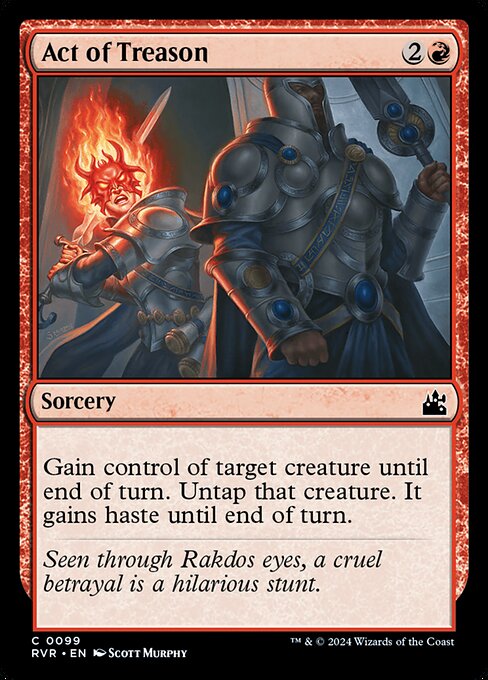
Image courtesy of Scryfall.com
Why Act of Treason's Rarity Impacts Its Value
Rarity is more than a cosmetic badge on a card; it’s a lens through which players and collectors read scarcity, playability, and the memory of the moment a card first shook up a game. When you look at Act of Treason, a red common from Ravnica Remastered, you’re watching a prime case study in how rarity informs perceived value in MTG. Its ability to steal a creature for a turn, untap it, and give it haste is a deceptively spicy tempo play for a common—exactly the kind of effect that can punch above its weight in the right deck, the right game, and the right nostalgia swing. 🧙♂️🔥
Act of Treason’s journey begins with cost and color: a three-mana spell with mana cost {2}{R}, landing squarely in red’s wheelhouse of impulsive, high-tempo plays. In the Ravnica Remastered set, a Masters treatment aimed at revisiting beloved cards with modern printing quality, the rarity remains common. That pairing—a strong effect plus a common rarity—creates a tug-of-war between utility and scarcity. On one hand, the supply is relatively robust due to reprints; on the other, the card’s versatility keeps it relevant in a wide array of formats, from Legacy to Commander. The dual pull keeps its market value buoyant enough to be noticed, even as you see the occasional dip after a reprint cycle. Value, after all, is a conversation between supply and demand, with nostalgia peppered in for good measure. 💎
Rarity as a signal: scarcity, reprint history, and set context
Common cards are often the backbone of draft and midrange strategies. They’re the cards you pull in bulk, the ones you sleeve up with friends, and the ones that quietly accumulate value through playability. But rarity also signals collectability: why do some commons spike in value while others languish? In Act of Treason’s case, it’s a combination of how frequently it appears in print, its enduring usefulness, and the bold, cheeky flavor that resonates with Rakdos storytelling. The line in the flavor text—“Seen through Rakdos eyes, a cruel betrayal is a hilarious stunt”—speaks to the card’s identity: a cheeky theft that’s as much vibe as victory. That cultural flavor adds an aspirational layer that can nudge a common card from “meh” to “must-have” for certain collectors. 🎭
Playability and value: tempo, presence, and formats
Act of Treason’s aura of excitement comes from targeting a creature, stealing it for a turn, untapping it, and giving it haste. It embodies red’s hallmark: a disruptive, tempo-forward interaction that punishes the opponent for committing their board. In formats like Modern or Pioneer, the card’s reprint history and its common status might temper price pressure, but its practical impact in Commander remains persistent. A single Act of Treason can turn the tides, letting a player swing wielding a massive threat or combo into an unexpected win. That margin for error—this surge of immediate advantage—helps preserve demand, even as the market sees spikes after big events or new reprints. If you’ve ever felt that rush of tempo as you steal a key attacker, you understand why rarity doesn’t always predict utility. ⚔️
- Foil vs non-foil: foil versions are consistently more collectible, often priced notably higher than their non-foil counterparts, even for a common. The foil’s sheen can elevate a card’s presence on the table and in display cases alike. 💫
- Collector value across reprints: Masters-style reprints in sets like Ravnica Remastered keep older cards today’s talk among collectors who want modern print fidelity without leaving the old-school vibe behind. 🧭
- Deck-building impact: in Commander, Act of Treason can enable clever political plays and dramatic swings, reinforcing the idea that a card’s rarity doesn’t tell the whole story about its power ceiling. 🧙
- Market signals: current prices—often modest for non-foil copies and higher for foils—reflect both supply from reprint cycles and ongoing demand from players who value the card’s tempo punch. 🔍
- Flavor and art: strong art and memorable flavor text contribute to a card’s aura, nudging collectors to seek copies that best capture the card’s personality—the sort of intangible value that rarity alone can’t quantify. 🎨
In short, the rarity classification of Act of Treason doesn’t eliminate its practical appeal; it reframes it. The card remains a staple that can spark a game’s momentum, while its common status keeps it accessible for players who want to test red’s aggressive tempo without a heavy investment. The result is a nuanced perception of value: not simply “scarcity = worth more,” but “scarcity plus playability plus cultural resonance = lasting appeal.” 🧙♂️💥
For collectors and players alike, that mix is part of what makes MTG so endlessly fascinating. The art, the lore, and the card’s role in shaping a game night all intertwine with price and rarity to create a narrative where even a humble common can shine at the right moment. If you’re curious to see how other cards in the same vein age in value, you can explore related articles and dig into the broader discussions of rarity, design, and market dynamics across our network. 🔎
Meanwhile, if you’re shopping for gear that pairs nicely with the MTG hobby, consider a touch of neon cyberpunk flair for your desk—a nod to the high-energy, high-contrast vibe that MTG players often carry from table to table. The product link below offers a way to bring that signature style into your everyday setup. 🧩
neon cyberpunk desk mouse pad customizable one-sided design-3mmMore from our network
- https://blog.digital-vault.xyz/blog/post/un-sets-unveiled-awakenings-lore-and-laughs/
- https://blog.rusty-articles.xyz/blog/post/subtly-striking-glossy-polycarbonate-case-for-iphone-16/
- https://blog.digital-vault.xyz/blog/post/discover-free-digital-paper-resources-for-beginners/
- https://crypto-acolytes.xyz/blog/post/can-gamers-benefit-from-crypto-trading-bots-risks/
- https://crypto-acolytes.xyz/blog/post/building-immersive-game-design-with-economic-storytelling/